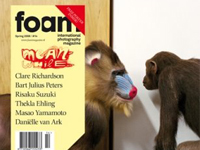
By Kathy Ryan
You're presenting a correlation between marks made in the world and artists that are composing and arranging and creating their own marks on the flatness of the photographic plane.
Ultimately, when you come into the exhibition this Spring, I want you to be able to make transitions from one artist to the next. It's the use of color and broad geometric shapes that makes the best transition from Tunbjork's photographs to the work of both Andreas Gefeller and Julian Faulhaber, who has a much more detached, sterile use of color in connection with the planes of architecture.
I was hoping we could talk a little bit about Gefeller, whose work I'm familiar with from Hasted Hunt Gallery, who has represented him here In the States for the lost few years. I was blown away by the grandiosity of the work which Is coupled with a specificity of detail. something that is uniquely photographic. There is a famous quote from Friedlander, where he says, 'I only wanted Uncle Vern standing by his new car (a Hudson) on a clear day. I got him and the car.l also got a bit of Aunt Mary’s laundry and Beau Jock, the dog, peeing on a fence, and a row of potted tuberous begonias on the porch and the seventy-eight trees and a million pebbles in the driveway and more. It's a generous medium, photography.” But Gefeller's work is such a flattening out of the space; at the same time, because of the sheer amount of detail, there is surprising depth. Friedlander's 'million pebbles' seem to be everywhere in his photographs.
That's exactly right. Both his and Faulhaber's photographs are crisp and modernist. They project everything that is a pure exploration of form , in contrast to the messiness of Ballen.
That's interesting. If you were just to say Ballen and Gefeller were in the same show and we hadn't had this conversation, , wouldn't know how to connect the dots. But you've pointed out the connections that are resonating for you.
That's good to hear, because I do see these connections. They are all individualists, and there are obsessions, but there are all of these links and connections to me. So much of the show includes artists that are riffing off the man-made world, and yet there is a real sense of abstraction. There is a visceral, purely sensual play at work here. And yet, because it's photography, it still relates to the real world.
Well, the more traditional documentary sense of photography is that the photographer must remain as absent as possible and show us the world 'out there.' What you're acknowledging through this show, and making clear, is a stance that has been around for some years, obviously, which is that the photographer/artist is always present – that much /s inescapable - no matter how objective the work pretends to be. You're acknowledging that and putting together artist s who are also aware of that. They show us bits of the world “out there” but seen through the filter of what's going on inside them. The work is unapologetic for this very interior view.